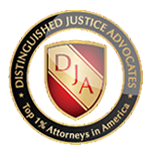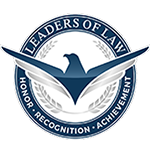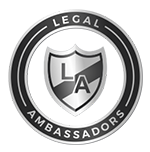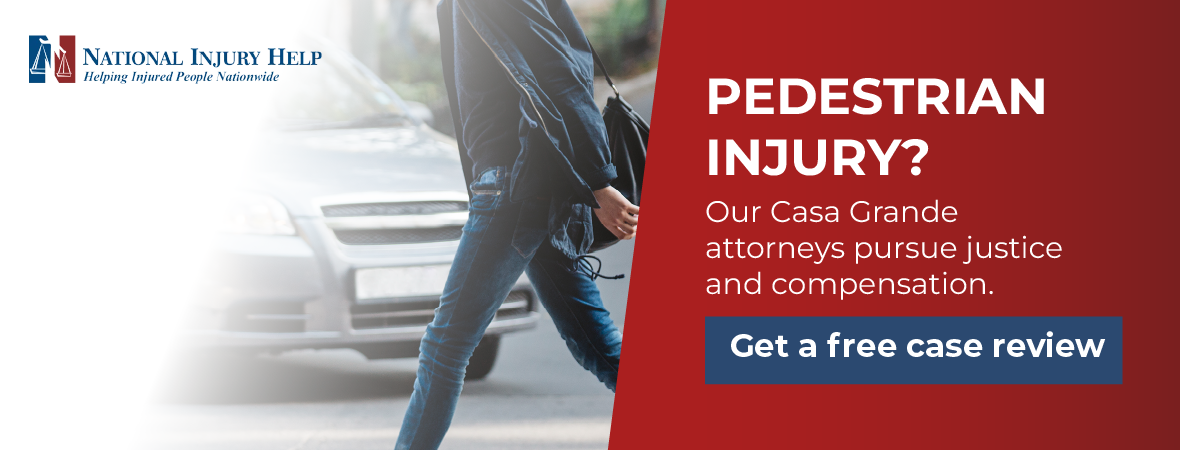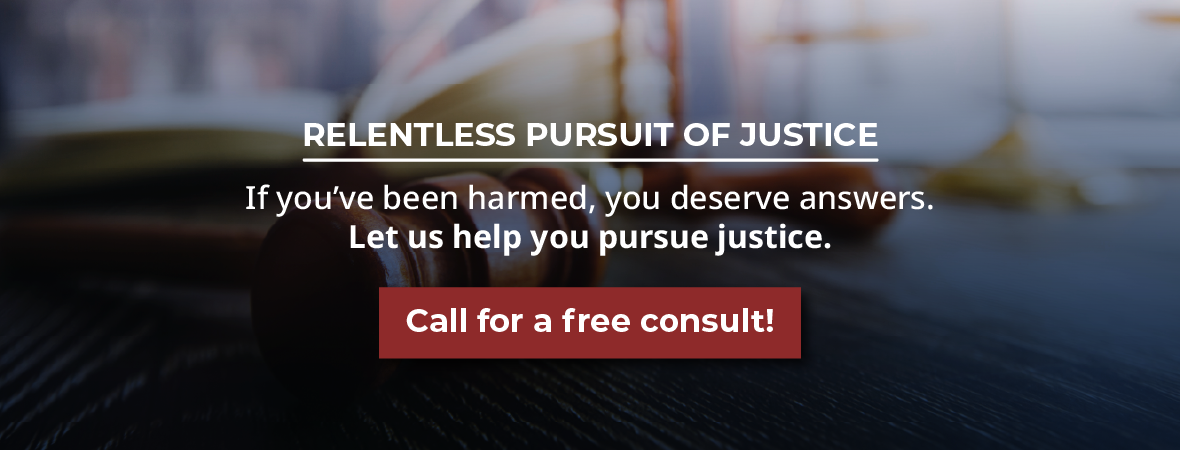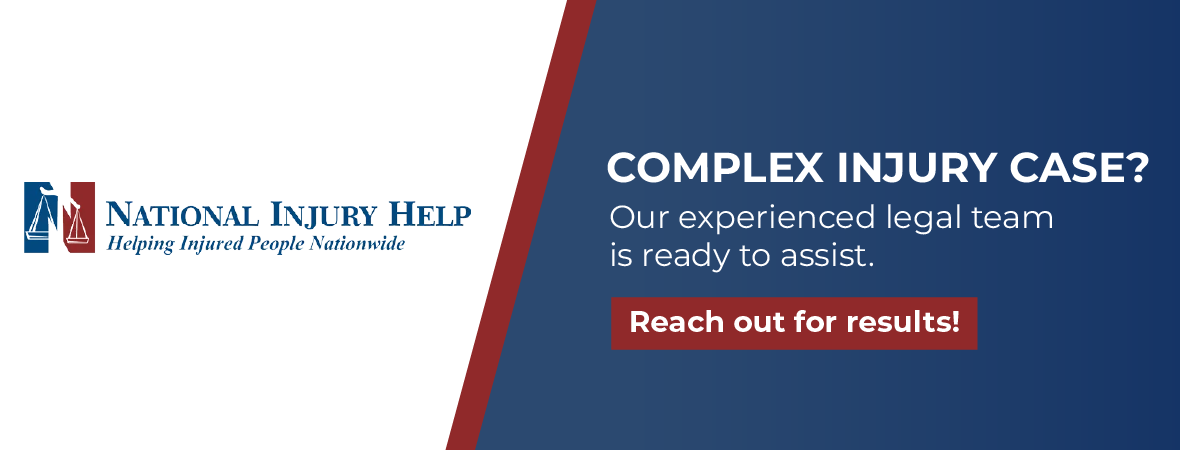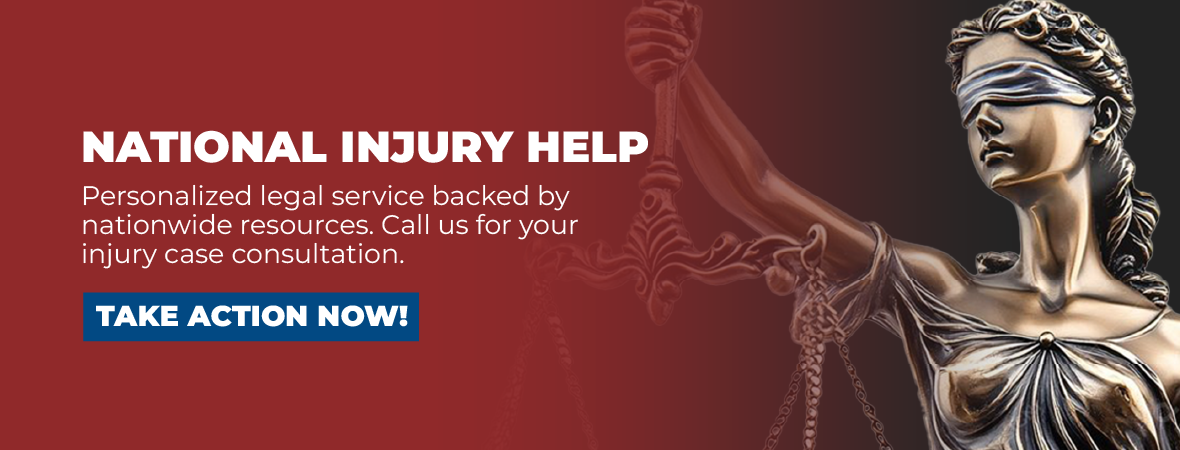Pedestrian accidents in Casa Grande can cause serious injuries and lasting stress. Contact National Injury Help today by calling 1 (800) 214-1010. We are here to guide you through the process and fight for the justice you deserve.
Casa Grande is a growing city, and its main routes, like Interstate 10, Trekell Road, and Cottonwood Lane, carry more vehicles every month. Drivers hurry to work, school, and grocery stores. Delivery vans search for addresses in new subdivisions where crosswalks are still unpainted and where streetlights do not yet reach every corner. The busy rhythm of this expanding landscape places walkers in constant danger, especially near wide intersections or in early morning dusk when visibility is low.
When you are hit by a car in AZ, from someone who deserves help that is both skilled and local, we grew up using these same roads, we know the patterns of traffic by heart, and we understand how Arizona law protects people on foot.
Our job at National Injury Help is to shoulder the legal problems that arise after an accident, so you can focus on medical care and family. You will learn why pedestrian collisions happen so often in Casa Grande, what injuries they cause, what steps you should take right after the event, which laws matter, and how fault can fall on more than one party.
We will also explain how we gather evidence, negotiate with insurance adjusters who may try to blame you, and take a case to court when fair payment does not arrive through settlement.
Common Causes of Pedestrian Accidents in Casa Grande
Crashes rarely result from pure chance. They grow out of predictable patterns that repeat day after day on the same stretches of road. We see these patterns in police reports, medical charts, and client stories, and we document them carefully to prove that the driver, or another party, broke a specific rule or chose a dangerous action.
Understanding these common causes helps you recognize how quickly a normal walk can turn painful and why strong legal help becomes necessary.
Distracted Driving
Phones, fast-food wrappers, and navigation screens all battle for a driver’s attention. A single text message may pull eyes from the street for five full seconds.
During that time, a vehicle traveling forty miles per hour covers more than the length of a basketball court. If you are stepping into a crosswalk at that same moment, the driver will not even touch the brake pedal before impact.
Mouth-to-mouth calls over a speaker or a split-second glance at a dashboard map can have the same result. Most drivers think they can multitask, but the human brain cannot focus on two demanding inputs at once. We obtain cell-phone records and electronic data from vehicles to show exactly when distraction stole attention away from the road.
Failure to Yield at Crosswalks
Arizona law gives pedestrians strong rights at both marked and unmarked crosswalks, yet many motorists either ignore or misunderstand those rights. At early morning drop-off near school zones, drivers concentrate on children exiting cars and forget to check for people crossing on foot.
At intersections without traffic signals, drivers sometimes slide through rolling stops because they believe no other cars are coming. They overlook walkers who cannot leap back to safety when a bumper edges forward. Photographs of skid marks, witness videos, and intersection diagrams all help prove that a driver failed to yield when the law required a complete halt.
Speeding in Residential or Downtown Areas
Florence Boulevard and Pinal Avenue were designed for lighter traffic decades ago, but population growth brought faster cars and larger trucks.
A driver who pushes ten or fifteen miles per hour above the posted limit may glance ahead and feel safe, yet that small increase in speed extends the stopping distance by several car lengths. When a person appears in the lane, the driver has no cushion left.
In quieter neighborhoods that feed into Cottonwood Lane, the same problem arises when drivers cut through side streets to avoid red lights. Speed studies and crash reconstruction software can tell us exactly how fast a vehicle traveled and why the driver could not avoid the collision.
Impaired or Fatigued Driving
Casa Grande weekends bring family gatherings, sporting events, and nightlife that stretches into the small hours. Some drivers then head home with alcohol, marijuana, or sleep deprivation clouding judgment. Impaired drivers drift across lane lines and miss traffic signals.
Fatigued drivers suffer from shortened attention spans and slower reflexes that mimic the effects of alcohol. Both risks climb late at night on Interstate 10 ramps and early in the morning on Trekell Road as night-shift workers head home. Blood tests, breath tests, and time-sheet records help connect this form of negligence to the crash that hurt you.
Poor Visibility or Inadequate Lighting
The desert sky around dawn and dusk creates a unique glare that hides people wearing ordinary colors. Streetlights along some stretches of Florence Boulevard fail to reach every inch of the sidewalk, or they may flicker after a monsoon storm.
Construction zones move barriers and leave dark corners where drivers expect clear paths. A pedestrian can obey every sign and still step into a shadow that renders them invisible until headlights reveal the silhouette too late. We examine lighting maintenance logs, weather reports, and photos taken at the same time of day to show how limited visibility contributed to the crash.
Common Injuries Sustained in Pedestrian Crashes
A human body built for walking cannot withstand the sharp forces created by a moving vehicle. Even collisions that occur below twenty miles per hour can send shock waves through bone, muscle, and internal organs.
The injuries you face may show up right away in an X-ray, or they may hide for days before pain surfaces. Each medical record becomes vital evidence that ties harm to the moment of impact.
Traumatic Brain Injuries
The head is often the first part of the body to strike a hood, windshield, or road surface. Concussions can cause headaches, dizziness, or nausea that linger for weeks. Skull fractures increase the risk of infection and bleeding.
Severe brain trauma can lead to trouble with speech, memory, or emotion regulation. These cognitive changes reshape work ability and family life long after physical wounds fade. Neurologists, neuropsychologists, and imaging specialists all contribute reports we use to explain why a settlement must include future therapy and support.
Spinal Cord Injuries
When a bumper hits the lower back or when the upper spine twists during a roll, vertebrae can crack or slip. Swelling around the spinal cord may block nerve signals, causing weakness or numbness in the arms or legs.
If the cord itself tears, paralysis may follow. Paralysis demands ongoing care that includes wheelchairs, home modifications, and in-home nursing. A life-care planner can predict those costs, and we place those figures in front of an insurance carrier or jury to ensure the award matches real future needs.
Orthopedic Trauma
Legs absorb huge forces because the car often hits below waist level. Broken hips, shattered tibias, and crushed feet can require multiple surgeries and long periods in casts or external frames.
Fractured wrists or elbows happen when the body instinctively tries to break a fall. Surgical hardware, physical therapy, and months away from work follow. We gather operative notes and rehabilitation plans to document every stage of recovery.
Internal Organ Damage
Seat belts protect drivers, but pedestrians have no such restraint. When the body meets a fender or the ground, ribs can crack inward and puncture lungs, or blunt force can bruise the liver or spleen.
Internal bleeding may not cause immediate pain, yet it can become life-threatening hours later. CT scans and surgical reports link these injuries to the crash and the need for intensive care, transfusions, or future monitoring.
Emotional and Psychological Harm
Impact trauma leaves scars that no camera can show. Post-traumatic stress manifests in flashbacks, nightmares, and fear of walking near traffic. Anxiety may surface every time you cross a street or even step off your porch.
Depression often grows when pain steals sleep and when missing work cuts off social contact. Licensed therapists and counselors keep records that describe this hidden toll, and we include their insights when we present your harms to insurers or a jury.
What to Do After a Pedestrian Accident in Casa Grande
Chaos rules the first minutes after a collision. Sirens approach, strangers ask questions, and pain clouds your thoughts. Clear steps taken early will protect both your health and your legal position.
Seek Immediate Medical Attention
Call 911 or ask a bystander to do so. Even if you feel only sore or shaken, accept transport to Banner Casa Grande Medical Center or go there as soon as possible.
Many severe injuries come with delayed symptoms, and waiting can risk your life as well as weaken your claim by letting insurers argue that the crash did not truly cause the later pain. Medical surveillance records pulse rate, blood pressure, and early imaging that link every condition to the accident.
Call the Police and Report the Accident
Ask the dispatcher to send officers from the Casa Grande Police Department. An official report creates an objective snapshot that insurance companies respect and that jurors trust.
When possible, describe the driver’s behavior, the direction of travel, and any witness names while the scene is fresh in your mind. Ask for the report number before you leave so that we can obtain the document quickly.
Gather Evidence at the Scene
If you can move safely, use a phone to photograph the license plate, the make and model of the vehicle, skid marks, crosswalk signals, and street signs. Turn the camera on yourself to show torn clothing, bruises, or bleeding.
Try to capture wide shots that show traffic flow, then closer shots of damage on the car or on your phone or watch, if those items were broken in the crash. These images freeze visual proof before tow trucks, rain, or routine cleanup removes it.
Do Not Speak to the Driver’s Insurer Yet
You may receive a call within hours from an insurance adjuster who sounds helpful and who promises quick payment. That adjuster wants to record your words and find any statement that suggests partial fault. Provide only your name, contact information, and the date and location of the accident.
Explain that you will speak again after consulting your attorney. Do not sign any medical release or settlement form before legal review because those documents often give insurers the power to dig through private records or to pay far less than the claim is worth.
Contact a Local Pedestrian Accident Lawyer
Evidence slips away as time passes. Traffic cameras overwrite footage, skid marks fade under new tire tracks, and witnesses change phone numbers.
The sooner you bring a lawyer onto your team, the sooner we can send preservation letters, hire crash reconstruction specialists, and organize your medical files. Early involvement strengthens negotiation and signals to the insurer that you will not accept an unfair offer.
Arizona Pedestrian Laws That Impact Your Case
Every crosswalk injury in Casa Grande rests on statutes and rules that define rights and duties. Knowing how these laws apply helps prove liability and defends you against accusations of wrongdoing.
Right-of-Way Laws at Crosswalks
Drivers must stop when a pedestrian is in any portion of a marked or unmarked crosswalk on their side of the roadway. The duty exists even at locations without traffic signals.
Many drivers believe that only painted stripes count, yet Arizona law states that a crosswalk extends across each leg of an intersection, whether lines are painted or not. When we show a driver failed to yield under this rule, liability becomes clear and settlements rise.
Jaywalking and Partial Fault
Crossing mid-block is common on wide streets where stoplights sit half a mile apart. Doing so is legal when no nearby intersection controls the lane, but the pedestrian must yield to cars if traffic is too close to stop in time.
Even if you crossed outside a crosswalk, you may still collect damages because drivers have a continuing duty to watch for people in the roadway. Under Arizona’s comparative fault system, any fault assigned to you only reduces your compensation by that percentage rather than eliminating it.
Arizona’s Comparative Negligence Rule
In a pure comparative system, you may recover damages even if you are ninety-nine percent at fault. Your award simply shrinks in proportion to your share of blame.
This rule becomes crucial when insurers try to argue that dark clothing, earbuds, or a non-signalized crossing make you fully responsible. We gather reflective gear receipts, daylight photos, and traffic engineering studies to shift fault percentages back onto the driver.
Statute of Limitations
You have two years from the date of the accident to file a lawsuit in Arizona civil court. Missing this deadline usually ends your right to compensation forever.
If the claim involves a city or county road design issue, you must file a formal notice of claim within one hundred eighty days, which is barely six months. Early legal action keeps your case safely within these timeframes.
Pedestrian Rights in School and Construction Zones
Special zones come with enhanced rules. Drivers must obey lower speed limits when lights flash near schools, and they must follow flaggers and reduced limits in construction areas.
Fines double for violations, and negligence becomes easier to prove because the driver ignored clearly posted warnings. Crash data from these zones often includes diagrams and photos made by work crews or school officers, which provides extra evidence for your case.
Who May Be Liable in a Pedestrian Injury Case?
Blame can rest on more than one shoulder. Each responsible party adds another insurance policy that can contribute to your recovery, which matters greatly when medical bills exceed a single driver’s limits.
Negligent Drivers
The most obvious defendant is the person behind the wheel. Speeding, distraction, impairment, and failure to yield all create direct liability. Their personal auto policy becomes the first source of payment.
Employers of Commercial or Rideshare Drivers
If the driver works for a business such as a delivery service, a rideshare company, or a utility provider, the employer may share responsibility under a doctrine that holds companies liable for the negligence of employees acting within the scope of work.
Commercial policies often carry one million dollars or more in coverage, which can cover surgeries, therapy, and lost income that normal auto policies cannot reach. We obtain work logs, app records, and dispatch data to link the driver to an employer at the time of the crash.
Government Entities
Poor signage, broken streetlights, and malfunctioning signals create traps for walkers. When evidence shows that the city or county knew about a danger and did not fix it, we include the government agency in the claim. Short deadlines and special procedures apply, so rapid investigation is key.
Property Owners
Parking lots funnel vehicles across walkways, and poorly designed lots may hide pedestrians behind pillars or shrubs.
If you are hit in a lot or on a private driveway, the business or homeowner may share fault for the unsafe design or for failing to trim vegetation that blocked a driver’s view. Premises liability rules allow recovery in these situations.
How a Casa Grande Pedestrian Accident Lawyer Helps You
Legal representation is far more than filling out forms. It is a partnership that turns raw facts into persuasive proof and that shields you from stress while you heal.
Conducts a Full Investigation
We visit the crash site, record every measurement, and collect paint transfer from the bumper if the car is still available. We subpoena surveillance footage from nearby stores, gas stations, and school cameras.
We hire accident reconstruction experts who calculate speed, angle, and stopping distance based on skid marks and vehicle weight. Their reports turn complicated physics into clear language a jury can grasp.
Collects Medical Evidence and Expert Testimony
Your doctors treat you, but they do not always write reports that connect each symptom to the collision. We request detailed statements, surgical photos, and future care plans.
When necessary, we bring in specialists who can explain how a traumatic brain injury will affect memory or how a spinal cord injury will require lifelong therapy. Economists translate those needs into dollar amounts that insurers must respect.
Handles Insurance Company Negotiations
Insurers use scripts designed to delay payment and to pressure victims into low settlements. We answer every letter, demand written explanations for denial tactics, and set firm timelines. Our presence signals that you know your rights and that you will pursue them to court if needed.
Files a Lawsuit If Necessary
If negotiations stall, we file suit in Pinal County Superior Court, drafting a complaint that covers every act of negligence. We engage in discovery, depose witnesses under oath, and file motions that limit the defense’s ability to present unfair evidence.
Trial preparation alone often prompts a higher settlement because insurers realize we stand ready to explain the truth to a jury.
Offers a Contingency Fee Model
Attorney’s no attorney fee unless we obtain money for you. We advance court costs, expert witness fees, and record charges out of our pocket. At the end of the case, we take an agreed-u percentage of the recovery. If we do not win, you owe no fee. This model allows you to hire skilled counsel regardless of your current finances.
What Compensation Can You Recover?
A fair settlement or verdict restores financial stability and supports healing. Arizona law allows recovery in several categories that reflect both economic and personal losses.
Medical Expenses
Compensation covers ambulance rides, emergency care, diagnostic scans, hospital stays, surgery, medication, physical and occupational therapy, home health aides, and any future procedures doctors expect you to need.
Lost Wages and Future Income
You can claim pay missed during recovery and the income you will lose if injuries prevent a return to your previous career. If you must work fewer hours or accept a lower-paying position, the difference is recoverable.
Pain and Suffering
Money cannot erase pain, but it recognizes how physical agony, sleep disruption, and daily discomfort diminish life. Settlements include this subjective loss because the law values human well-being.
Loss of Enjoyment of Life
When injuries stop you from hiking Casa Grande Mountain, playing sports with children, or even walking unaided to the mailbox, you lose a basic joy. Damages compensate for hobbies, social events, and independence taken away.
Punitive Damages in Extreme Cases
If the driver acted with extreme recklessness, such as street racing or driving very intoxicated, Arizona courts may award punitive damages. These payments punish wrongdoing and serve as a warning to others.
FAQs About Pedestrian Accidents in Casa Grande
Can you sue if you crossed outside a crosswalk?
Yes, you can still sue if you crossed outside a crosswalk because Arizona comparative negligence still allows recovery reduced by your share of fault.
What if you did not go to the hospital right away?
Delayed care can complicate the case, but medical experts can link later symptoms to the crash with imaging and timeline analysis.
How long do you have to file?
Generally, you have two years to file, though shorter limits apply if the government is involved.
Will you have to go to court?
Many cases settle, but if insurers refuse a fair amount, we are ready for trial and will guide you at every step.
What if the driver fled the scene?
We work with police, obtain nearby camera footage, and pursue uninsured motorist coverage on your own policy if the driver fled the scene and remains unidentified.
Contact a Casa Grande Pedestrian Accident Lawyer Today
Every minute after a pedestrian crash matters. Tire marks fade under new traffic, cameras record over old videos, and memories lose detail. Calling a lawyer quickly preserves the proof that supports your claim and locks in important deadlines.
Our firm understands the flow of traffic on Trekell Road, the timing of lights on Pinal Avenue, and the filing customs of the Pinal County courts. That local knowledge speeds investigation and strengthens negotiation.
National Injury Help offers free consultations, and you pay no fee unless we secure compensation. We serve Casa Grande, Arizona City, Eloy, Maricopa, Coolidge, and every community in the desert corridor. If you were hit while walking in Casa Grande, do not wait. Call 1 (800) 214-1010 today, speak with a lawyer who cares about your recovery, and take the first step toward justice and the financial stability you need to move forward.

